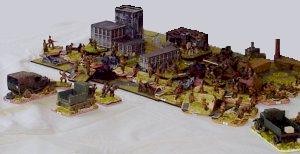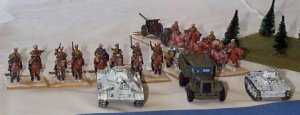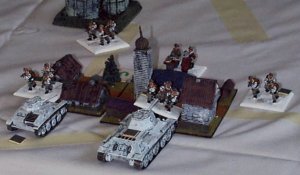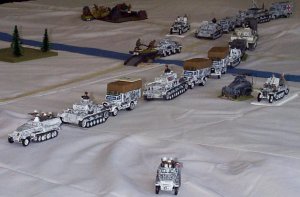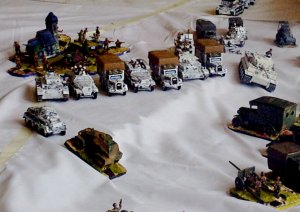|
The Battle The battle started with the Soviets furiously assaulting the western outskirts of Stalingrad and mopping up a number of isolated pockets of German troops. 6. Panzer-Division's recce pushed forward to the Myscowa River with the rest of the Division strung out behind. Seeing this new threat, the Soviets moved up whatever troops were at hand to defend the river line while redoubling their efforts to eliminate isolated pockets and the defenders of Stalingrad. They also launched a diversionary attack against the main German airbase at Pitomnik Airfield in the hope that this would draw off German strength from the main attack. Fast moving Cossack Cavalry were sent in a long sweeping move towards this objective. Subsequent moves saw 6. Panzer-Division burst through the Myscowa River defence line and press on towards Stalingrad. During breaks in the weather Stukas attacked the Soviet artillery park exposed on the wind swept steppes. Perceiving this as the main threat, the Soviets launched their Tank Corps into the flank of 6. Panzer-Division hoping to slow or stop their advance. However they reckoned without the tricky Von Gow whose 14. Panzer-Division chose this moment to appear from the south west. With the remaining Tank Brigades supporting the Cossack attack on Pitomnik, there were no reserves left to oppose them. Desperately the Soviets threw Sturmovik attacks against the long columns of 14. Panzer-Division, but the veteran flak crews fought back with determination and relatively little damage was done. The end came fairly swiftly after this. 6. Panzer-Division's faced the Soviet Tank Corps across barren steppe. The veteran crews of 502. Schwere-Panzer-Abteilung tore huge gaps in the Soviet Tank Brigades, and suddenly the Soviets had no defence between Stalingrad and the advancing Panzers. At this moment a Romanian Infantry Regiment under the command of the General Cartrescu heroically punched through the Soviet infantry to link up with the spearhead of 14. Panzer-Division. The one success for the Soviets was the capture of Pitomnik, and as the battle ended Cossack Cavalry streamed across the airfield whilst the last Stuka squadron tried desperately to get their machines into the air. While failing to prevent the German link up, the Soviets capture of Pitomnik would certainly hinder German efforts to consolidate their success so it was not a complete failure for them. |
|
